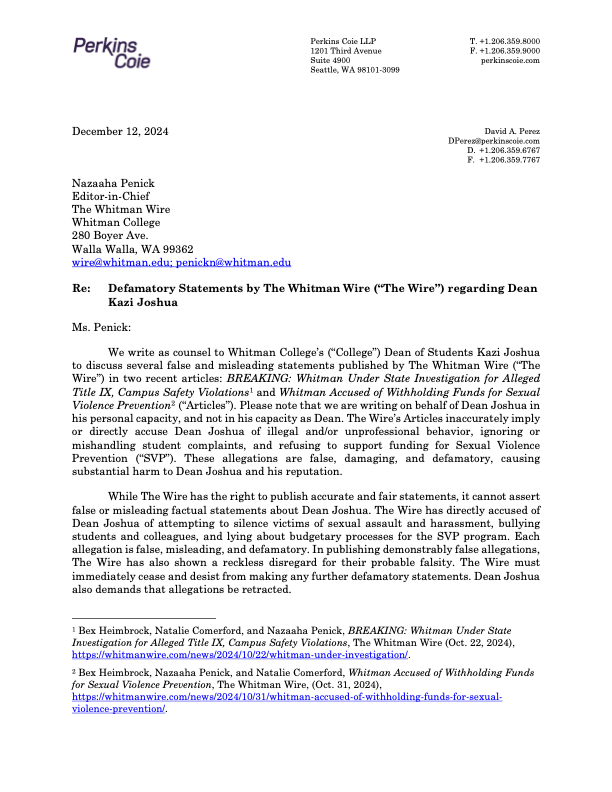Over the past 10 years, some departments at Whitman College have grown dramatically. Meanwhile, some departments are still quite small, while others are even shrinking. We took a look at some of Whitman’s smallest departments in order to examine the advantages and difficulties that come with tiny class sizes.
Mathematics
The number of students majoring in mathematics (including the math-economics and math-physics combined programs) has fluctuated in the past 10 years, ranging from nine to 25. Despite this irregularity, the Mathematics Department maintains a very stable number of course offerings.
According to Professor of Mathematics Patrick Keef, the Mathematics Department is not so much a major-oriented department as a “service department.” It enrolls many non-majors, either for distribution requirements or in courses that are prerequisites for other departments, like physics.
“People are taking [the calculus sequence] from across the campus, [and] pretty much the entire statistics curriculum is a service-oriented curriculum for people who may not become math majors,” said Keef.
Keef says that the service-oriented nature of the department is typical in most math departments nation-wide.
“Everybody who works in a math department across the country understands that things like the calculus sequence are our bread and butter,” said Keef. “At a [school like] Whitman College there are no graduate students to teach those classes. So you don’t come to a Whitman College unless you’re willing to teach those classes.”
Keef mentioned a disadvantage of being a service-oriented department: the comparatively small number of courses specifically designed for math majors. Keef estimated that only a quarter of the department’s offerings each year are geared completely towards math majors, but he was optimistic that the department’s hiring of a second statistician will allow these offerings to expand.
“We would like to be able to offer, besides the regularly-scheduled classes, two [to] four classes specifically designed for majors, and we’re hopeful that with the addition of a new statistician we’ll be able to do that within the next few years. It will make the major, I think, significantly stronger,” said Keef.
History
The number of students majoring in history has experienced a decline. In 2006, the college graduated 36 graduating history majors; in the class of 2015, there are 17.
“We’re not crazy about the fact that our numbers are lower. We’d like to have more majors since we’re a very well-staffed department,” said Associate Professor of History and Paul Garrett Fellow John Cotts, who is the current chair of the History Department.
Cotts is quick to point out that this downturn is not unique to Whitman. According to the American Historical Association, the number of history degrees conferred hit an all-time low in 2013.
“History majors have been in decline across the country since 2008, and most observers think that this is because of the economic downturn and the search for more ‘practical’ majors,” said Cotts.
Given the successful career outcomes of Whitman’s history majors after graduation, Cotts rejects the notion that the history major is an impractical one. He also pointed to a few steps the department has taken to get more students interested in the history major.
“We have introduced a new rubric [called] History 150, Reading Sources … It’s especially pitched at first-years. It’s a seminar format without much lecture to introduce students to a particular historical topic,” said Cotts. “We had two of them this year and we’ll be repeating both of those courses next year because they both filled.”
There are 17 history majors graduating in the current school year at Whitman and 21 juniors will graduate with a history degree in 2016, so Cotts is not concerned about the department’s future.
“The numbers tell us that this year we have a little more than last, and we’re going to have more next year. 2013 and 2014 are rock bottom in terms of enrollment, and then we’ll start getting back to where we were 10 years ago,” he said.
German Studies
For departments like German, a small number of majors is nothing new. Since 2006, the number of graduating German studies majors has ranged from one to four. There are currently two German faculty members.
Senior Adjunct Professor of Foreign Languages & Literature Susan Babilon sees many benefits to having a predictably small number of majors.
“We get to know our students really well and can tailor subtopics within a course to address individual students’ particular interests,” said Babilon in an email.
Since certain courses in other departments, such as history, religion and art history can count towards the German Studies major, Babilon says it’s never too difficult to offer enough classes to allow the majors to fulfill their requirements.
“What they take away from those classes [in other departments] helps them draw larger comparisons and connections between German and other disciplines across campus,” said Babilon in an email.
Babilon does not seem to mind the fact that her department is so small.
“The German expression: ‘Klein aber fein’ fits well,” she said in an email. “‘Small but really special.’ They’re a wonderful group of students and German provides them with great opportunities.”
Astronomy
By contrast, the astronomy faculty sometimes find it difficult to run a department with only two professors.
The Astronomy Department certainly plays what Keef of the Mathematics Department would call a service role. The department offers four different introductory courses, which draw potential majors and students fulfilling distribution requirements. These courses are generally over full.
According to Associate Professor of Astronomy & General Studies Andrea Dobson, the department is in need of a third faculty member. Dobson cited small classes as one reason students choose Whitman, and she sought another faculty member to allow the department to offer more introductory classes, each with lower enrollment.
Even though introductory courses are often bursting with students, the upper-division classes range from eight to twelve students. There are only six astronomy majors graduating this year, and the since 2006 that number has never risen past eight (including students doing combined majors in astronomy-physics and astronomy-geology.) Dobson is very happy to have a small number of majors.
“In some ways it’s almost like a graduate department. There’s a small number of people, [but] there’s a critical mass of people. It’s more than just one or two,” said Dobson.
Dobson says that every astronomy major gets the opportunity to assist with labs and work with professors, which is rare in undergraduate departments.
“[In the past 10 years,] when we moved up from one or two majors graduating each year to maybe five or six, their grades got better because they work together, they cooperate, they help each other,” she said.
Overall, professors find that despite some disadvantages, there are many benefits to running a department with a small number of majors. The size of different departments varies widely because different departments serve different purposes on campus.
“Some [departments] have large numbers of enrollment because they are serving other departments, and some have large numbers of majors, and that’s what they do,” said Keef. “Each department has a different role.”




